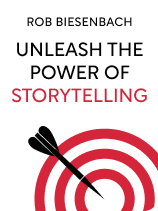

This article is an excerpt from the Shortform book guide to "Unleash the Power of Storytelling" by Rob Biesenbach. Shortform has the world's best summaries and analyses of books you should be reading.
Like this article? Sign up for a free trial here.
Do you give presentations at work? Are you ever called on to make a toast? Does your company have an origin story that needs to be told?
Stories have an important place in presentations, whether you’re pitching an idea, introducing a product, or giving a lecture. In Unleash the Power of Storytelling, Rob Biesenbach provides practical advice for using storytelling in presentations, including your corporate story and even a toast or eulogy.
Keep reading to learn how to engage an audience by using storytelling in presentations.
Storytelling in Presentations
A story can capture your audience’s attention before they know who you are or what you represent and can persuade them to take the action you want them to take. Telling a great story requires the same elements and calls on the same skills regardless of where you tell the story. And, most of the advice in Unleash the Power of Storytelling applies pretty much anywhere you’d find yourself in front of an audience. But, in some situations, many of us could use more guidance. We’ll explain Biesenbach’s advice for using storytelling in presentations in general. Then, we’ll share some recommendations that are specific to explaining the story of your organization and giving a toast or eulogy.
When you give a presentation, Biesenbach recommends that you should start with a story, end with a story, and tell more stories in between (interspersed with a variety of types of information that communicate your message). Begin your presentation with a story that speaks to a problem your audience cares about—a story that sets up and reinforces the message of the presentation.
Include stories throughout the presentation as needed, making sure to vary the kinds of information that you’re presenting to your audience. (For Biesenbach, this tends to involve one story for each section of the presentation.)
End your presentation with a story that reinforces your message. Biesenbach explains that it can be particularly effective to tell a story that continues the story you told at the beginning of the presentation by adding a twist, appending a postscript, or telling it from another character’s point of view.
(Shortform note: Experts agree that stories make a presentation more effective. In Talk Like TED, Carmine Gallo notes that listeners have an easier time understanding an idea if you use a story to tell them how it works in the real world. But not everyone agrees that you need a story at the beginning, middle, and end of a presentation. One design agency points out that when your entire presentation is built around a story, you only need that one story. But if you’re working on a presentation that’s about a bigger idea, then it makes sense to have two or three stories to provide examples throughout the presentation, perhaps at the beginning, middle, and end. You might even need more than three stories if you’re tackling a big question.)
A Company Origin Story
Biesenbach explains that businesses, nonprofits, and other organizations need an “origin story” that presents their history and purpose and humanizes the people behind the scenes.
When you’re telling a corporate story, you need to tailor the story to what the company can do for the audience. Like any good story, this kind of story needs a relatable character and a clear theme. Biesenbach notes you should pick just one value proposition to focus on rather than trying to address everything the company does. Many company origin stories follow a familiar pattern, which you can adapt:
- The founder encounters a problem.
- They make a discovery or invent a solution.
- They turn their idea into a product or service.
- They grow their business.
- The business continues to operate on its original values.
A Toast or Eulogy
You can use a story to frame your thoughts when you need to make a toast, speak on a special occasion, or deliver a eulogy. The sentiment you want to communicate can be more impactful in a story, and the momentum of a story can also help you get through an emotional moment.
When you know you’ll need to speak at an emotional moment, Biesenbach recommends practicing your story, bringing your notes with you, pausing if you lose your composure, and minimizing eye contact if it helps you get through the speech.
When composing a eulogy, Biesenbach recommends focusing on one character trait and telling a story that illustrates it. Then, you can explain the impact that that particular incident made on you. If you’re speaking about someone with whom you have a complicated relationship, focus on one thing that you find admirable about the person and speak honestly about it.
(Shortform note: If there’s one thing that writing advice on toasts and eulogies unanimously agrees on [other than the usefulness of telling a story], it’s the importance of specificity. Telling a story about someone who has passed away can help you write a eulogy that feels personal, truthful, specific, and memorable. In a toast honoring newlyweds or honorees at another special occasion, the right anecdote can illustrate the relationship you have with the honorees and relate their specific qualities to the context of the occasion.)

———End of Preview———
Like what you just read? Read the rest of the world's best book summary and analysis of Rob Biesenbach's "Unleash the Power of Storytelling" at Shortform.
Here's what you'll find in our full Unleash the Power of Storytelling summary:
- How telling a story can make any message more compelling
- The unique power stories have to influence us and shape our emotions
- The crucial pieces that make up a story (other than the beginning, middle, and end)






